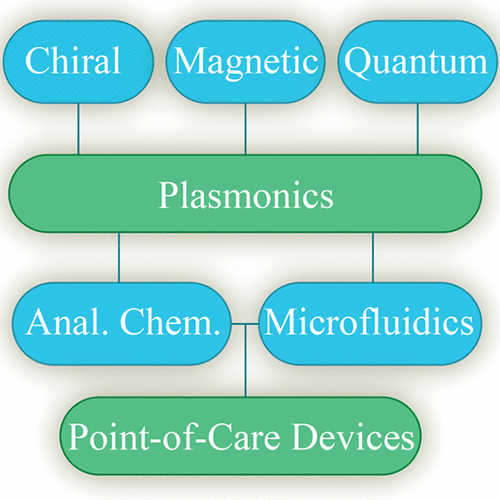当前位置:
X-MOL 学术
›
Chem. Rev.
›
论文详情
Our official English website, www.x-mol.net, welcomes your
feedback! (Note: you will need to create a separate account there.)
Plasmonic Biosensing
Chemical Reviews ( IF 51.4 ) Pub Date : 2018-09-24 00:00:00 , DOI: 10.1021/acs.chemrev.8b00359 J. R. Mejía-Salazar 1, 2 , Osvaldo N. Oliveira 2
Chemical Reviews ( IF 51.4 ) Pub Date : 2018-09-24 00:00:00 , DOI: 10.1021/acs.chemrev.8b00359 J. R. Mejía-Salazar 1, 2 , Osvaldo N. Oliveira 2
Affiliation

|
Plasmonic biosensing has been used for fast, real-time, and label-free probing of biologically relevant analytes, where the main challenges are to detect small molecules at ultralow concentrations and produce compact devices for point-of-care (PoC) analysis. This review discusses the most recent, or even emerging, trends in plasmonic biosensing, with novel platforms which exploit unique physicochemical properties and versatility of new materials. In addition to the well-established use of localized surface plasmon resonance (LSPR), three major areas have been identified in these new trends: chiral plasmonics, magnetoplasmonics, and quantum plasmonics. In describing the recent advances, emphasis is placed on the design and manufacture of portable devices working with low loss in different frequency ranges, from the infrared to the visible.
中文翻译:

等离子体生物传感
等离子体生物传感技术已用于生物相关分析物的快速,实时和无标记探测,其中主要挑战是检测超低浓度的小分子并生产用于即时点(PoC)分析的紧凑型设备。这篇评论讨论了等离激元生物传感的最新趋势,甚至是新兴趋势,并利用了新颖的平台,这些平台利用了独特的物理化学特性和新材料的多功能性。除了对局部表面等离子体激元共振(LSPR)的公认使用之外,在这些新趋势中还确定了三个主要领域:手性等离子体,磁等离子体和量子等离子体。在描述最新进展时,重点放在便携式设备的设计和制造上,这些设备在从红外线到可见光的不同频率范围内以低损耗工作。
更新日期:2018-09-24
中文翻译:

等离子体生物传感
等离子体生物传感技术已用于生物相关分析物的快速,实时和无标记探测,其中主要挑战是检测超低浓度的小分子并生产用于即时点(PoC)分析的紧凑型设备。这篇评论讨论了等离激元生物传感的最新趋势,甚至是新兴趋势,并利用了新颖的平台,这些平台利用了独特的物理化学特性和新材料的多功能性。除了对局部表面等离子体激元共振(LSPR)的公认使用之外,在这些新趋势中还确定了三个主要领域:手性等离子体,磁等离子体和量子等离子体。在描述最新进展时,重点放在便携式设备的设计和制造上,这些设备在从红外线到可见光的不同频率范围内以低损耗工作。











































 京公网安备 11010802027423号
京公网安备 11010802027423号